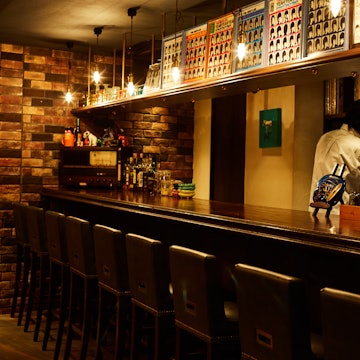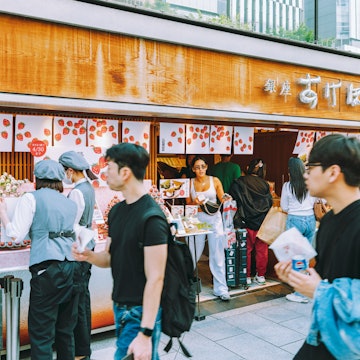

It doesn't get much more quintessentially Japanese than the landscape of the Yamanashi Prefecture © DoctorEgg / Getty Images
Napa, Marlborough, Bordeaux and … Yamanashi? Japan’s up-and-coming wine country might not roll off the tongue as automatically as the world’s more widely lauded wine making regions do. But thanks to an inherent Japanese taste for the finer things and prime growing conditions for a native grape (the koshu varietal) on the slopes north of Mt. Fuji, you can expect to start hearing a growing buzz around wines from this mountainous Prefecture.

Japanese vistas and vineyards
Yamanashi Prefecture – the cradle of Japanese wine making and the country’s largest wine-growing region – is one of Japan’s most scenic regions, less than two hours by train west of Tokyo’s Shinjuku station in the region of Chūbu.
‘Compared to famous wine regions around the world Yamanashi is relatively small, with fewer than 100 wineries,’ says Sera Goto, an œnologue with a degree from the University of Bordeaux who spent ten years consulting in the Japanese wine industry and is an accredited judge for the Japanese Wine Challenge. ‘Only 600 hectares of vineyards are planted for wine production here compared to over 15,000 for Napa Valley and 30,000 for Burgundy. Many of the vineyards are located on the hillsides, in pergola form, to allow better circulation of air.’
But while the region itself may be small, Japan’s appreciation for fine wine, says Goto, is not. ‘Globally, the Japanese love wine. I think they love wine itself and its role in cuisine, but also the idea of it – that it's inevitably linked with history and culture and gastronomy, that there is endless variety and discovery, and that it can be equally appreciated with casual sipping or with lifelong study.’
Koshu, the indigenous varietal drawing visitors for wine tasting in Yamanashi vineyards is a pink-skinned grape making a clean, crisp white wine that’s ‘elegant and focused, and whose yuzu, lemongrass, nashi pear and sea spray notes go perfectly with Japanese seafoods,’ Goto says.
And while Japan faces many challenges to grape growing, including the often-devastating typhoon season, Yamanashi benefits from a rain and wind shadow cast by Mt. Fuji that shelters the region from the brunt of nature’s wrath. ‘(Just a decade ago in Yamanashi), few wineries had formal tasting rooms, and owners were surprised to be contacted for a tasting,’ Goto says. But nowadays, tasting rooms are common and organized wine tours are growing in popularity in the region.
Explore everything the region offers
You can arrive in Yamanashi prefecture by train, but renting a car to get around on your own is preferable — not only because many of the wineries here are distanced from the train stations and accessible by car only, but because the region is dotted with hot springs and beautiful gorges like Nishizawa that are a thrill to explore. Pair the area’s spectacular nature with tasting rooms that often have views of the Japanese Alps or Mt. Fuji itself, and you’re in for a treat.
At Marufuji Winery, terraced vineyards meet iconic Japanese garden elements such as bonsai trees. You can try wines made from both 100 percent koshu grape as well as the Muscat Bailey – a varietal, which makes a pleasing light- to medium-bodied red wine that Goto says pairs well with dishes like teriyaki barbecue platter. Right nearby, the Maruki Winery, established in 1891, claims to be the oldest winery in Japan and also makes wines from koshu grapes while delighting younger visitors with a petting zoo of sorts. The vineyard has resident sheep onsite that help with weed control, and kids love the chance to see them frolicking amongst the vines.
Tomi no Oka Winery is another major Yamanashi player to put on your tasting itinerary, with vineyards spread across a scenic mountainside. Try white wines made from koshu grapes as well as chardonnay and riesling in addition to Muscat Bailey A, pinot noir and other red varietals.

Grape-to-bottle: uniquely Yamanashi
If you prefer to visit Japan and the Yamanashi region as part of a small group tour or exclusive private tour, InsideJapan Tours offers Koshu vineyard tours to explore the wine making process from grape to bottle. The tours visit four family-run wineries and are offered as part of a full Japan travel package that may see you spending the night inside the Unesco World Heritage listed Ninna-ji Temple as part of your itinerary.
‘The (Yamanashi) vineyards are not like the sprawling estates of other growing regions in Europe or the United States,’ says Jeff Krevitt, of InsideJapan Tours. ‘Most of the wineries are clustered around a handful of villages, and walking through the neatly-planted vineyards and along village pathways from one to the other is an easy and pleasant experience.’
However you choose to see Yamanashi, the region’s grapes and winery visits are just the tip of the iceberg when it comes to all there is to taste and do.
‘Yamanashi is also famous for its luscious peaches, plums, table grapes, and cherries, as well as sweet corn which is sold roasted on the cob at roadside markets,’ says Goto. ‘Autumn colors are very vivid, and in winter it's a good region to visit for hot spring baths.
Get more travel inspiration, tips and exclusive offers sent straight to your inbox with our weekly newsletter. Make the most of your travel with sightseeing tours and activities from our trusted partners.
https://shop.lonelyplanet.com/products/best-of-japan-travel-guide-1
















